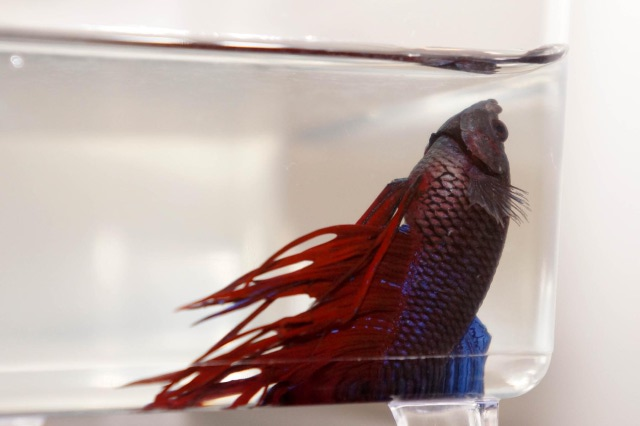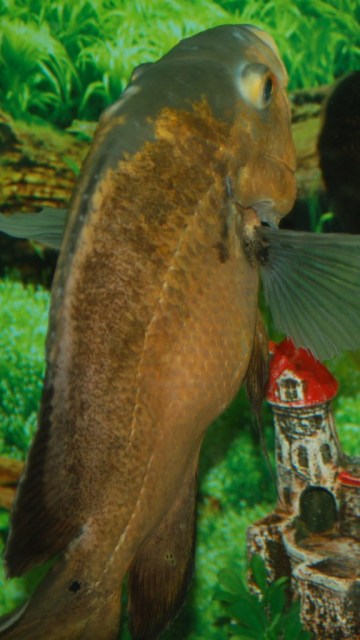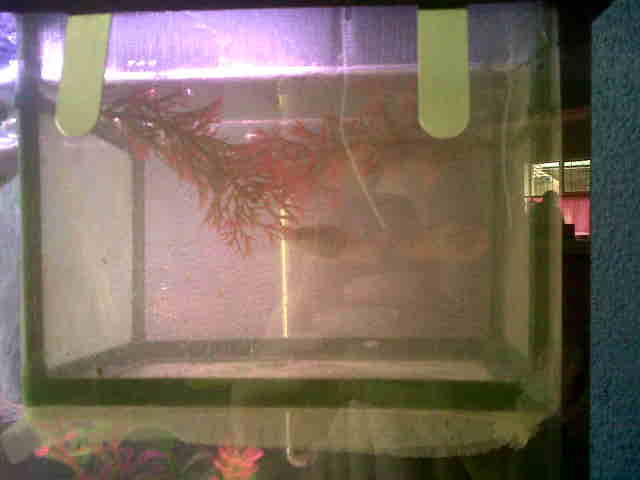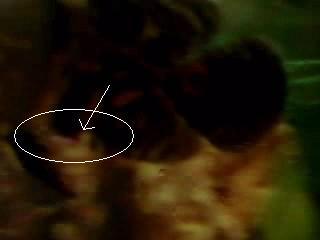QuestionWe have three guppies in a ten gallon tank we only had them for about one month . My son noticed that one of the fish tails looks like it is disappering. What do we need to do?
AnswerHi Lynn;
The first thing to do is replace 25% of the water. Whenever fish aren't acting quite right it's just a good thing to do. A water change lowers waste toxins and infectious organisms that could be bothering them, as well as giving their immune system a boost from the fresh clean water. Make sure the new water is the same temperature as the old water and add a good water conditioner to the tank before refilling the tank with the new water. All tanks need a 25% water change every week to keep the fish in good health.
Your tank is still pretty new so it could be trying to finish the break-in period. It can cause the fishes' fins to deteriorate as well as burn the gills, eyes and skin. The water change will help. Get a sample of water to your local fish store and ask them to test it for you. Many do it for free or just charge a small fee. You need to know what the ammonia (NH3), nitrite (NO2) and pH levels are. Knowing the ammonia and nitrite levels will tell you if the tank has completed it's first bio-cycle. They both will be at "zero" if it has done so. It means that beneficial bacteria is doing it's job and is finally maturing, consuming the toxins. If either are elevated at all, do another water change and test again the next day. Do a 25% water change every day that either toxin is up. The water changes help to dilute the toxins and make them more tolerable for the fish. You can even buy the kits to test the water yourself. Don't let the fish store tell you after they test the water that the levels are "fine" or are "okay". Get the actual levels of them. Don't let them talk you into buying a chemical or anything else to "solve the problem" either. It's their job to sell stuff but you don't need it. Water changes are more effective, more healthy, more reliable and much less expensive.
It is also possible that the affected fish is being picked on. Be sure that you have at least 2 females per male. Males want to breed constantly and will wear out a female if there aren't enough to distribute their, um, "amorous" attention amongst. ;-) If you have all males, they may simply be picking on each other. They live to breed and are looking for another fish to do that with. Sometimes it means fighting amongst males.
Here is my article on new tanks so you know what this crazy process is all about;
**********
New Tank Syndrome or Break-in Period
So you have a new tank and you filled it up, put the filter together, mounted the heater into place and turned on the lights. You have all the plants and decorations where you want them....
You are ready for fish.
But, your filter is not ready for a full tank of fish yet.
The filter is running and moving the water and cleaning out crud, right? Of course!
But a very important part of your filter is the part you can't see. An aquarium filter removes the larger visible stuff, but it also must remove the dissolved fish waste that turns into ammonia in the water. To do this, special bacteria must grow in the filter system and on the particles of gravel in the bottom of your tank. This process occurs even on a limited scale in little fish bowls that have no filter in them.
This is "New-Tank Syndrome" or the "Break-in Period". The entire process takes 6 to 8 weeks to complete because these "nitrifying" bacteria grow quite slowly.
Start off with only one or two hardy fish (no more than 2 total inches of fish) for every ten gallons of water and don't add more until the 6 to 8 weeks has gone by. Hard to be patient, but it is worth it to keep your fish alive and healthy. As a matter of fact, the bacteria cannot develop without fish in the tank. You can let that tank sit forever without fish in it, but as soon as the first fish goes in the process begins. Avoid changing the filter pads during break-in. This removes the bacterial colonies that are essential to a balanced aquarium. You can rinse the filter pad out in a container of aquarium water. This will preserve most of the bacteria colonies while still allowing your filter to flow freely. Even using bacteria additives and water conditioners when you first set up the tank will not make a tank begin the cycle by itself. If there are no fish to provide food (fish waste) for the bacteria, the beneficial bacteria cultures will die and you will have to start the colonies all over again once fish are added to the tank. Once the tank has completed the initial cycle, you can change the filter pads every 4 weeks or so. But for now, just rinse them.
Feed your new fish VERY lightly. Any excess food will cause additional waste your system cannot afford to have right now. If you see food floating around or lying on the plants and gravel after five minutes, too much food is going into the tank. Cut back a little each time you feed until it is ALL gone 5 minutes after you feed them. Feed them once a day.
During this "break-in period" your tank will become cloudy and milky looking. You may have to tolerate this for the entire break-in period but it is only temporary. Changing 25% of the water three times a week until the break-in period is over helps a great deal. Changing water reduces the ammonia and nitrites that rise while the bacteria continues to multiply. If ammonia and/or nitrites become too high, your fish will become stressed and possibly die. Use a good water conditioner when you replace the water and make sure it is the right temperature to avoid shocking your fish.
When the break-in is over after 6 to 8 weeks and there are no nitrites or ammonia present in the water you can slowly add more fish. Add one or two every week until you reach the desired population. This allows the bacteria to adjust to the new population every time before adding more. Monitor the nitrites and ammonia to be sure they don't come up. If they do, make a 25% water change and check them again. Don't add the next fish until the levels are down again.
The safe maximum population for any size tank is one inch of adult fish for every gallon of water in the tank. Do some research to be sure of the fish you are interested in. Even though they are small when you buy them, you have to base your population calculations on full-sized adult fish. Many hobbyists have up to two inches per gallon but this can be risky. If a water quality issue arises or a disease occurs it will spread fast and furious in an over-populated tank. In any case, 25% water changes every week to two weeks are absolutely essential for the health of your fish.
Following these guidelines will help you get your new tank on the right track.
**********
At Your Service;
Chris Robbins
Come on over and join us on the freshwater fish forum at About.com to get even more information too;
http://freshaquarium.about.com/od/questionsanswers/a/naavigateforum.htm

 Betta has big belly
Question
Sick little Red
My betta is 1 year old
Betta has big belly
Question
Sick little Red
My betta is 1 year old
 5 Year Old Female Oscar Large Lump On Each Side Trouble Breathing
Question
Here Is The Picture Of
Hello Ron.
5 Year Old Female Oscar Large Lump On Each Side Trouble Breathing
Question
Here Is The Picture Of
Hello Ron.
 are my mollie about to drop fry?
QuestionQUESTION: Hello all, hope youre doing good ;-)m
are my mollie about to drop fry?
QuestionQUESTION: Hello all, hope youre doing good ;-)m
 Sucky Fish with white fuzz
Question
sucky fish with white
I have a 30 gallon tank
Sucky Fish with white fuzz
Question
sucky fish with white
I have a 30 gallon tank
 swollen butt/ possible worm
Question
fishs butt
I currently have a red tiger oscar.
swollen butt/ possible worm
Question
fishs butt
I currently have a red tiger oscar.